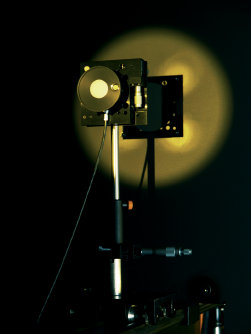Illuminance
The illuminance E corresponds to the luminous flux per m2 hitting an area that does not emit light. So, it indicates how strongly an object is illuminated. The unit of the illuminance is the lux (lx) (lux, Latin: light). The illuminance at your desk should be about 300 lx – 500 lx.

At the BEV the lux is realized by a photometer, the sensitivity of which is calibrated by luminous intensity standard lamps. The illuminance at the photometer diminishes by the square of the distance r from the light source and is proportional to the luminous intensity I. The simple relationship is: E=I/r2. A photometer consists essentially of a silicon photo diode (working principle like a solar cell) and an upstream optical filter. The filter is constructed in such a way that the resulting spectral sensitivity of the instrument comes close to the spectral responsivity of the human eye (see fundamentals). Then the illuminance is proportional to the photo current generated in the instrument.
Measuring instruments for illuminance, which have already an indication of the unit lux, are also called luxmeters. At BEV illuminances up to 3000 lx can be generated.